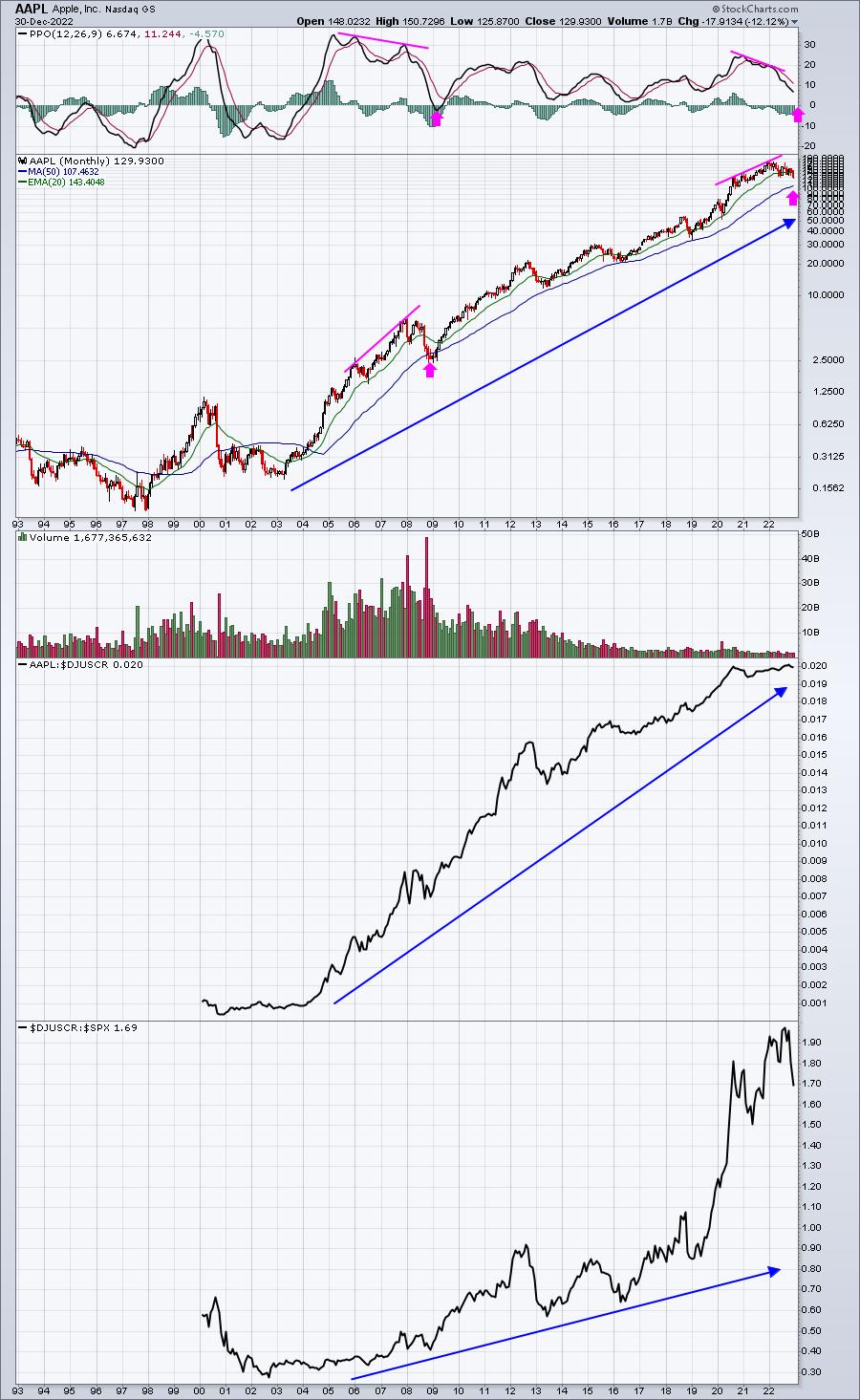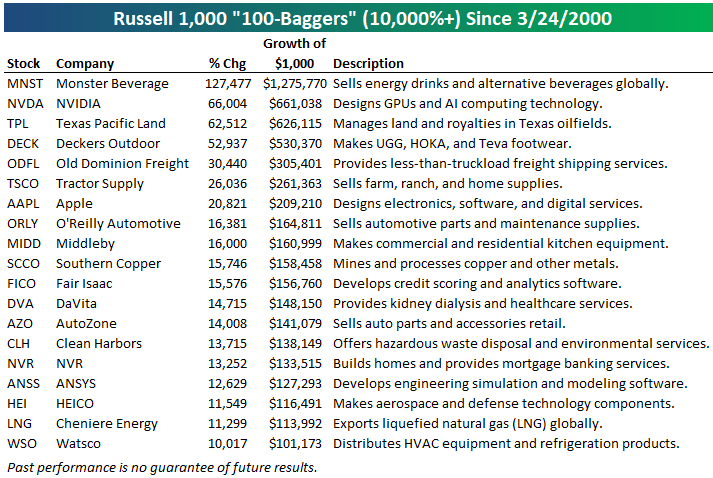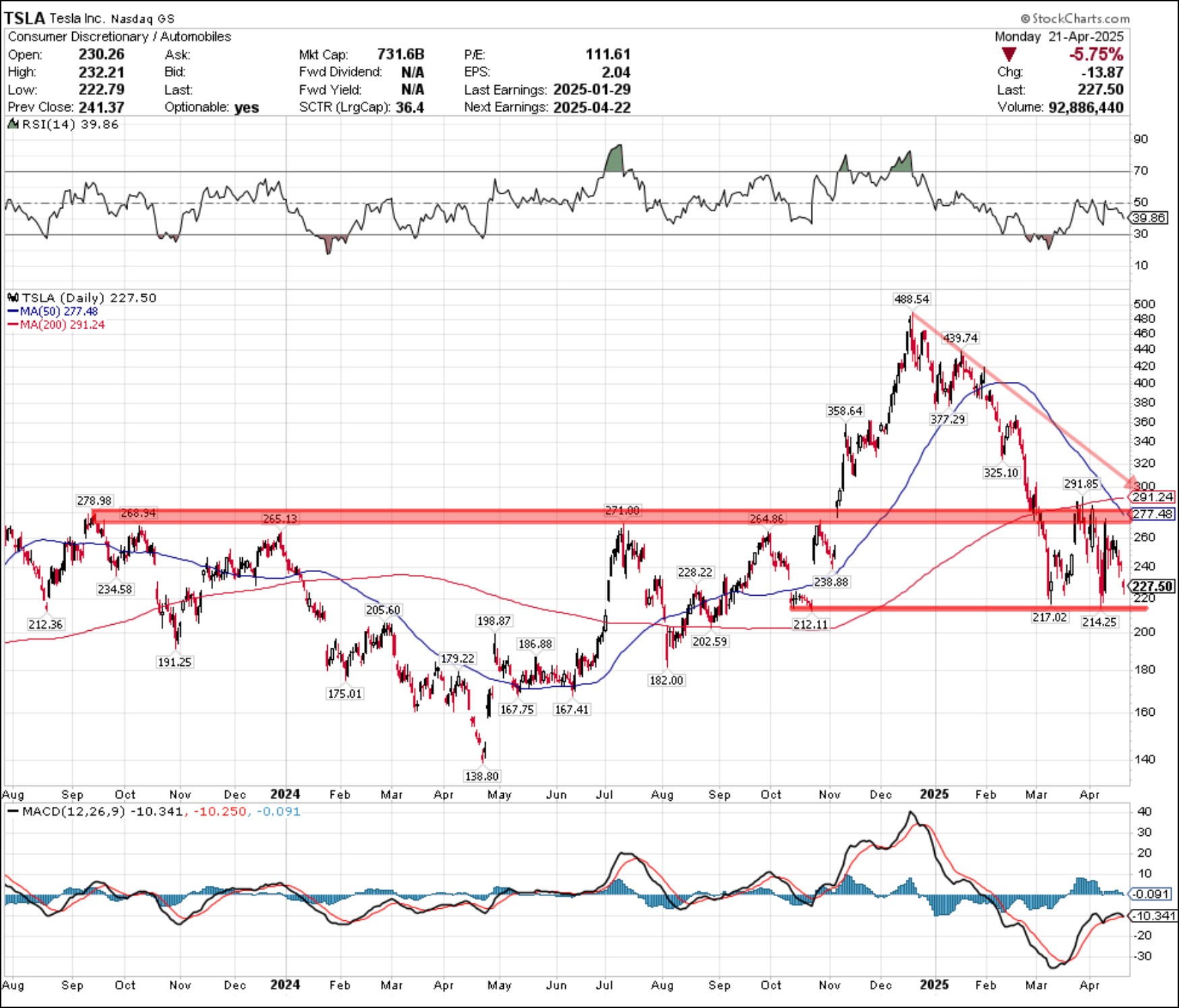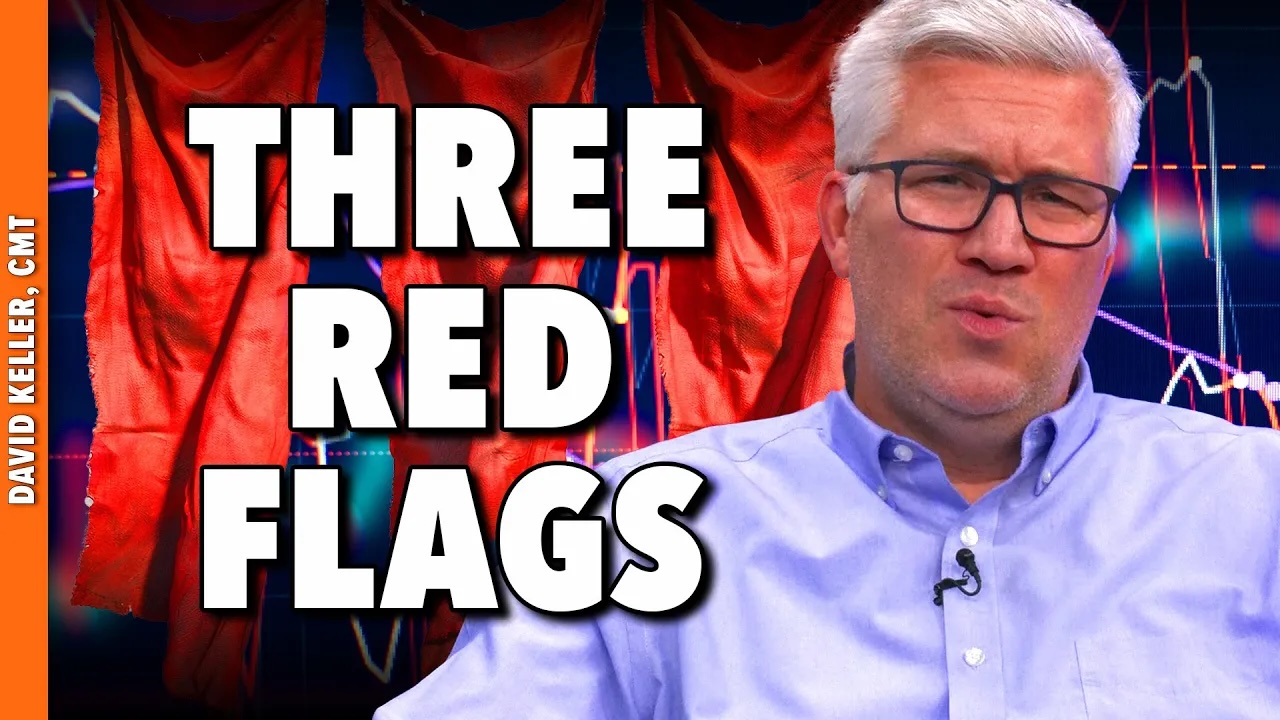First of all happy new year!!! I hope 2023 will be a healthy and prosperous year for everyone!
If we look back at 2022, it was anything but that. We started the year very sourly and it went downhill from there – at least from a stock market perspective. There’s hope as we head into 2023, but we need to change a few things before we can really move up.
Large caps need to recover
Our main indices such as the S&P 500 and the NASDAQ 100 are mainly driven by the performance of large caps. These are two market-cap weighted indices, meaning large-cap stocks like Apple, Inc. (AAPL) and Microsoft (MSFT) will bear a heavy burden. The following six companies represent more than 20% of the S&P 500 and nearly 42% of the NASDAQ 100. Unless they recover and start to outperform, they likely have another tough year ahead. Here’s a quick look at each of the six long-term monthly charts:
AAPL:
AAPL remains in a long-term uptrend, which is good news. However, it has recently printed a negative divergence. When we saw the negative divergence in 2008, we know what happened. It was a brutal foray into the 50-month SMA to “reset” the PPO to its zero line. Right now, AAPL’s 50-month SMA stands at 107. AAPL broke below its 129.50 2022 support late last week. If the ship fails to be repaired, a possible trip to the 50-month SMA cannot be ruled out.
MSFT:

Monthly PPO has been very maxed out at MSFT as it has been moving higher unabated for a decade. The 2022 sell-off was necessary, but now that MSFT has seen a 50-month SMA test, I feel better about it moving forward in 2023.
AMZN:
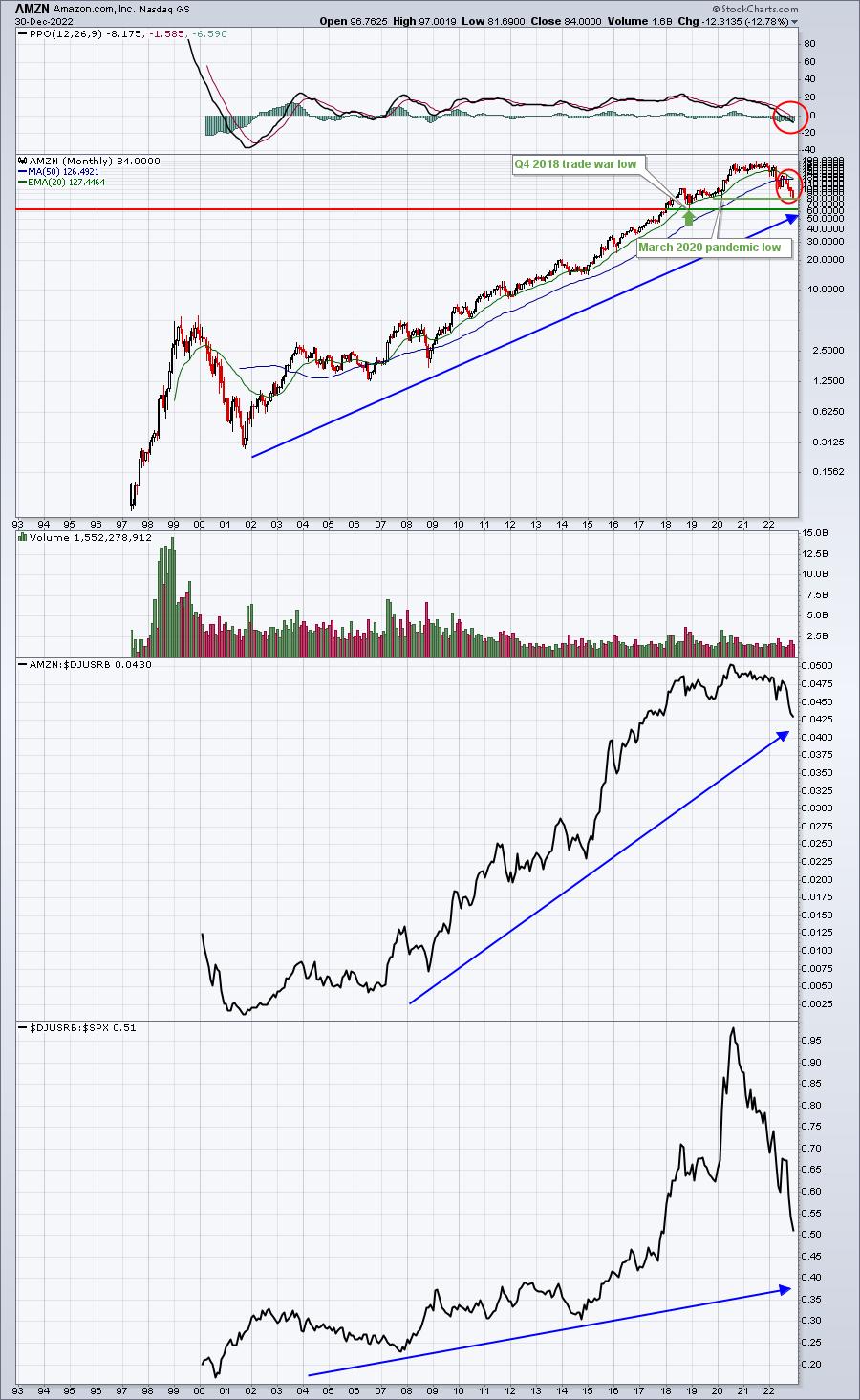
AMZN has been one of the biggest beneficiaries of the COVID-19 pandemic. From its pandemic-related low in March 2020, AMZN was trading at 81.11. After a rise to 177.20 in early September 2020, which was well over a doubling of the share price in just 6 months, we had another move higher to 188.21 in July 2021. From there, however, it was a ski run on AMZN’s chart. On Friday, AMZN closed 2022 at 84.00 – almost exactly where its 2020 pandemic run began.
Google:
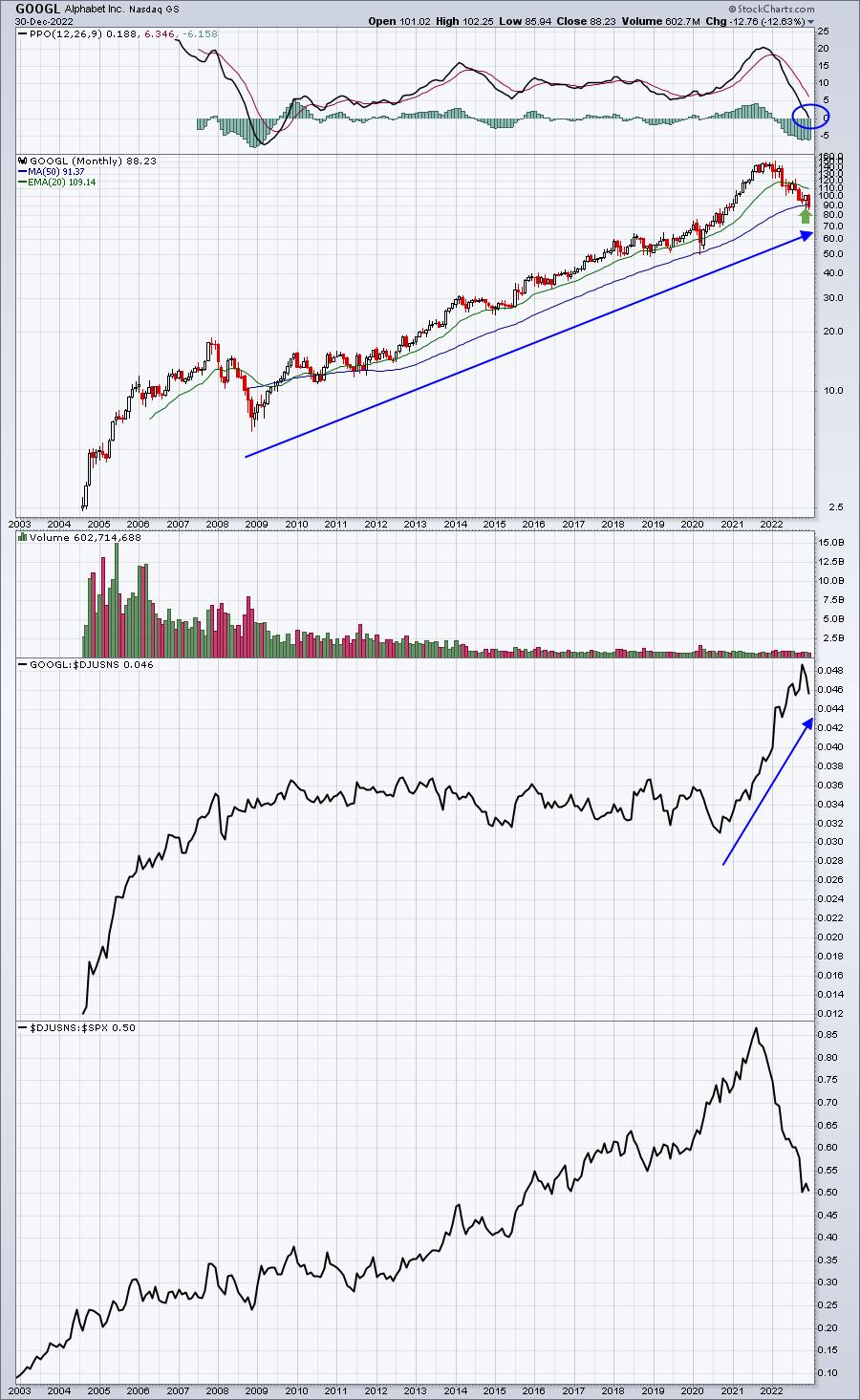
Alphabet (GOOGL) has seen a steady decline in 2022, but it has crushed many of its internet peers. GOOGL remains a clear leader in this space. However, internet group ($DJUSNS) was the fourth worst industry group overall (out of 104). GOOGL has now tested its monthly PPO midline and 50-month SMA.
TSLA:
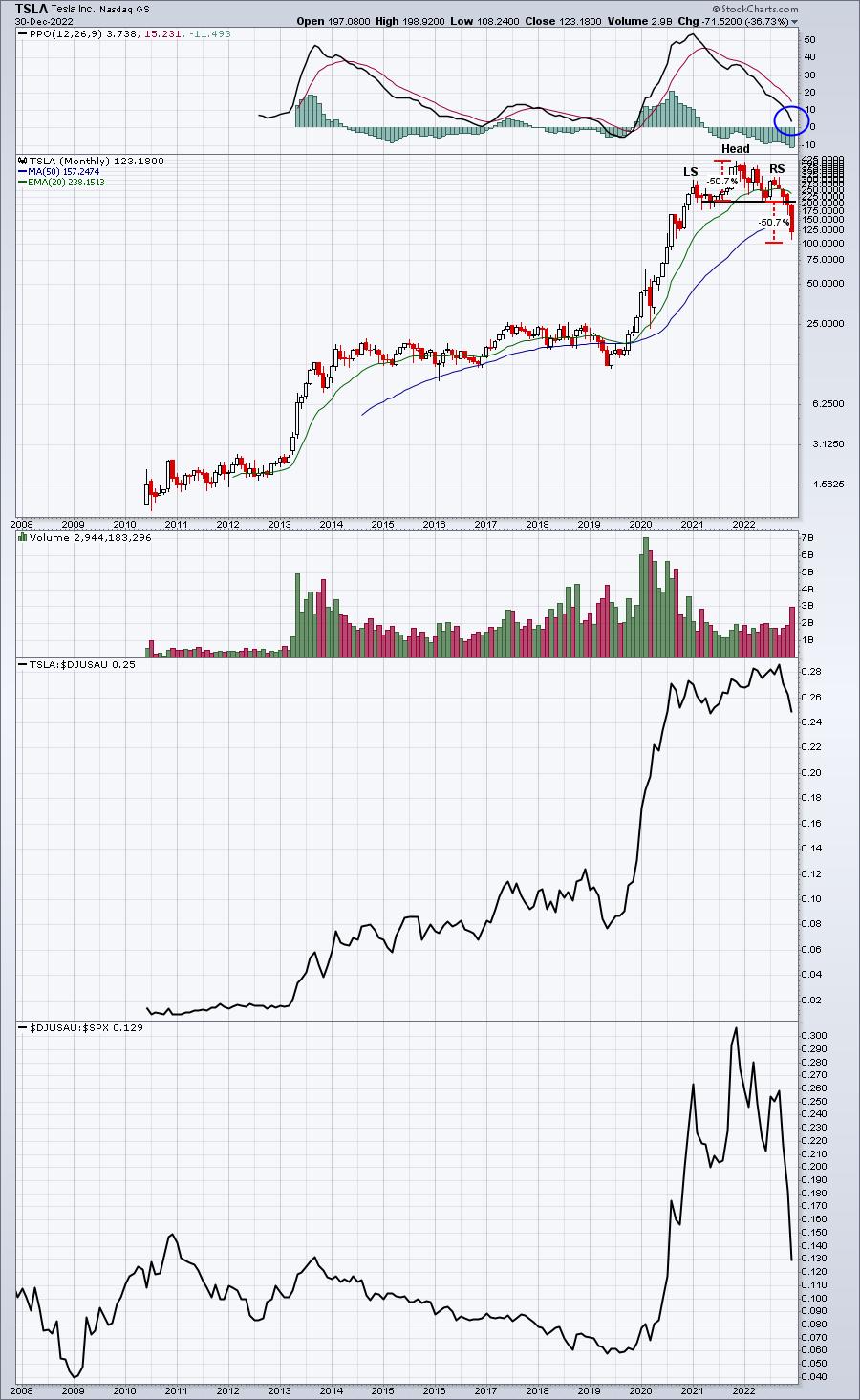
After a massive run up in TSLA shares, a head and shoulders top emerged… and it has now been broken to the downside. Since neckline support gave way in November, TSLA is up nearly 50% additionally fall. I don’t know if December’s huge drop of 37% marked a bottom, but I think the reading has been reached. TSLA is currently one of the weakest stocks on the entire market, but my gut tells me that a year from now the chart will be very different.
NVDA:

NVDA has seen this type of decline before – during the trade war in the fourth quarter of 2018. Many semiconductor stocks were devastated during this period, but the 50-month SMA provided support. Here we are, just a few years later, in a similar spot. Attempting a bounce off the 50-month SMA has encountered some difficulties at the now bearish 20-month EMA, so we could remain range bound for a while.
History tells us this is the time to buy, not sell, these mega-cap leaders. Do they have other disadvantages? Well possible, but their long track record is undeniable. I remember so many people saying, “I want to see a pullback on these names” as we ended 2022 at record levels. But now that we’ve seen a 30% to 70% drop in these 6 stocks, nobody wants to touch them. This is how losing money affects our psyche.
Currently, the technical conditions for the NASDAQ 100 and its component stocks are not looking good, but all is not lost.
Seasonality to the rescue?
The last month of each calendar quarter (that is, the 3rd, 6th, 9th, and 12th calendar months) has historically not been good for technology. Here’s a breakdown of the average 3-month outperforming or underperforming of technology versus the S&P 500 this century within any quarter:
- Month 1: +2.5%
- Month 2: +3.8%
- Month 3: +0.4%
The technology shows a history of sales during the 3rd months of our calendar quarters – of which December is one. January tends to be a lot stronger for technology stocks and the NASDAQ as a whole. Over the past 50 years, the NASDAQ has gained an average of 2.39% in January, while the S&P 500 has gained an average of just 1.05% over the same period. The “January Effect” is a powerful indicator of annual performance. In 2022 it worked perfectly again.
If you want to know how the stock market will perform in 2023, it could be as simple as watching the 6 stocks above over the next month. Are they showing signs of upward movement? Are they trending further down? Of course, these won’t be our only signals, but certainly ones to watch for.
Market Forecast 2023
I’ll be sharing my 2023 forecast this Saturday, January 7th at MarketVision 2023, and you won’t want to miss it. Here were excerpts from my last 3 annual market forecasts:
Market Vision 2020:
S&P 500 closing price, December 31, 2019: 3230.78
My prediction for 2020: Bullish and close to 4040
How the Year Raised: After the devastating effects of COVID-19 in March 2020, the S&P 500 rallied strongly, moving from the pandemic low of 2191.86 to a close of 3756.07. I remained bullish on the 2020 pandemic, calling it a “cyclical” bear market.
Market Vision 2021:
S&P 500 closing price, December 31, 2020: 3756.07
My prognosis: bullish and close of 4756.07 – said we would gain 1000 points
How the Year Raised: The S&P 500 trended higher throughout 2021, stumbling somewhat in September before a fourth quarter rally brought us to 4766.18 by year-end. The win was 1010 points. I missed my call by just 10 points.
Market Vision 2022:
S&P 500 closing price, December 31, 2021: 4766.18
My prognosis: Bearish with a downside target of 3500-3800 in the first 3-6 months (said we could see 20%-25% cyclic bear market)
How the year progressed: The first six months were rough and the cyclical bearishness was confirmed as the decline hit 20% by May. On June 16th, I called a market bottom as the S&P 500 touched 3636. I expected a rally in the fourth quarter.
I don’t have a crystal ball. But I use technical price action, key fundamentals, history, prospects, and just plain common sense to develop my stock market forecast. Though many have tried to label me a “perma bull,” I hope my prediction for 2022 put that to bed. I say what I see, it’s as simple as that. It’s impossible to always be right. I’m just trying to manage risks.
And now it’s time to do it again. I would like to invite you to join me along with StockCharts.com’s David Keller, Julius de Kempenaer and Grayson Roze as we share our approach to 2023. It really will be the best educational event of 2023 and it’s FREE virtual event. Watch from the comfort of your own home! To find out more about the event and to BOOK your place, CLICK HERE. Nobody else does an event like this for FREE. No one. By the way, if you can’t do the event live, we’ll send you a recording, so be sure to register!
Distinguish yourself by attending MarketVision 2023 – see you there!
Happy New Year and happy trading!
Tom

Tom Bowley is the Chief Market Strategist of EarningsBeats.com, a company that provides a research and education platform for investment professionals and individual investors. Tom writes a comprehensive Daily Market Report (DMR) that provides guidance to EB.com members every day the exchange is open. Tom has brought technical expertise here at StockCharts.com since 2006 and also has a fundamental public accounting background which brings him unique skills to approach the US stock market.


